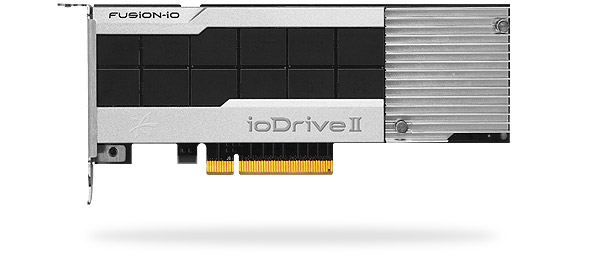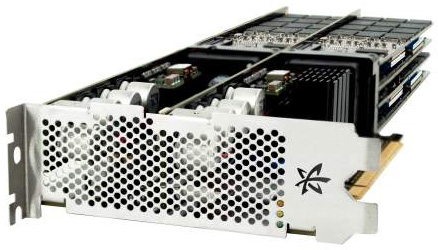The Impact of Disruptive Technologies on the Professional Storage Market
by Johan De Gelas on August 5, 2013 9:00 AM EST- Posted in
- IT Computing
- SSDs
- Enterprise
- Enterprise SSDs
Fusion-IO: the Pioneer
Fusion-IO is telling everyone that wants to listen that it is much more than the vendor of extremely fast PCIe flash cards. Despite the fact that it sells quite a few cards to the storage giants like NetApp, Fusion-IO wants nothing less than to completely change and conquer the storage market.
Fusion-IO's first succesful move was to sell extremely fast ioDrives to the people who live from scale-out applications like Facebook and Apple. These companies ditched their traditional SAN environments very quickly as replacing centralized shared storage by a model where hundreds of servers have a local PCIe flash storage system gave them up to ten times more storage performance at a fraction of the cost of a high-end SAN system.
Ditching your centralized storage is not for everyone of course: your application has to handle replication and thus be able to survive the loss of many server nodes. But as we all know, that is exactly what Google, Facebook, and other scale-out companies did: build applications that replicate data between nodes so that nobody has to worry about a few failing nodes.

The Iodrive: up to 3TB, hundreds of thousands of IOPS
Although scale-out customers were extremely important to Fusion-IO, the company also went also after the virtualization market where centralized storage is king. The ioTurbine is a Hypervisor plug-in that enables server side caching on a virtualized host with a Fusion-IO flash card. The beauty is that ioTurbine does not disable the typical goodies that centralized storage offers in a virtualized environment such as vMotion and High Availability. ioTurbine works with ESXi, Windows 2012/2008 and RHEL.
Fusion-IO ION Data Accelerator is the next generation SAN: PCIe Flash cards inside any decent x86 server, like the Supermicro 6037 or the HP DL380p. ION is typically used for high-end database clusters. Fusion-IO promises that this shared storage can deliver no less than 1 million IOPs.
With the acquisition of NexGen Storage, Fusion-IO is also targeting the midrange market by offering a “flashpool” kind of product. The key difference is that NexGen Storage can use write-back caching, while most vendors do no or limited writing on the flash disks. The Fusion-IO software is also able to provision a certain amount of IOPs for each LUN.
.jpg)
But more than anything else, the Fusion-IO products are offering extreme speeds. Even a one array NexGen N5 series targeted at SMBs promise 100K-300K IOPs, more than any of the much more expensive midrange SANs can offer right now.

The fastest product, the 10TB ioDrive octal, costs around $100k and delivers 1 million IOPs. Even if those numbers are inflated, it is roughly an order of magnitude faster and cheaper (per GB) than the NetApp “Flash Cache”.










60 Comments
View All Comments
Jammrock - Monday, August 5, 2013 - link
Great write up, Johan.The Fusion-IO ioDrive Octal was designed for the NSA. These babies are probably why they could spy on the entire Internet without ever running low on storage IO. Unsurprisingly that bit about the Octal being designed for the US government is no longer on their site :)
Seemone - Monday, August 5, 2013 - link
I find the lack of ZFS disturbing.Guspaz - Monday, August 5, 2013 - link
Yeah, you could probably get pretty far throwing a bunch of drives into a well configured ZFS box (striped raidz2/3? Mirrored stripes? Balance performance versus redundancy and take your pick) and throwing some enterprise SSDs in front of the array as SLOG and/or L2ARC drives.In fact, if you don't want to completely DIY, as many enterprises don't, there are companies selling enterprise solutions doing exactly this. Nexenta, for example (who also happen to be one of the lead developers behind modern opensource ZFS), sell enterprise software solutions for this. There are other companies that sell hardware solutions based on this and other software.
blak0137 - Monday, August 5, 2013 - link
Another option for this would be to go directly to Oracle with their ZFS Storage Appliances. This gives companies the very valuable benefit of having hardware and software support from the same entity. They also tend to undercut the entrenched storage vendors on price as well.davegraham - Tuesday, August 6, 2013 - link
*cough* it may be undercut on the front end but maintenance is a typical Oracle "grab you by the chestnuts" type thing.Frallan - Wednesday, August 7, 2013 - link
More like "grab you by the chestnuts - pull until they rips loose and shove em up where they don't belong" - type of thing...davegraham - Wednesday, August 7, 2013 - link
I was being nice. ;)equals42 - Saturday, August 17, 2013 - link
And perhaps lock you into Larry's platform so he can extract his tribute for Oracle software? I think I've paid for a week of vacation on Ellison's Hawaiian island.Everybody gets their money to appease shareholders somehow. Either maintenance, software, hardware or whatever.
Brutalizer - Monday, August 5, 2013 - link
Discs have grown bigger, but not faster. Also, they are not safer nor more resilient to data corruption. Large amounts of data will have data corruption. The more data, the more corruption. NetApp has some studies on this. You need new solutions that are designed from the ground up to combat data corruption. Research papers shows that ntfs, ext, etc and hardware raid are vulnerable to data corruption. Research papers also show that ZFS do protect against data corruption. You find all papers on wikipedia article on zfs, including papers from NetApp.Guspaz - Monday, August 5, 2013 - link
It's worth pointing out, though, that enterprise use of ZFS should always use ECC RAM and disk controllers that properly report when data has actually been written to the disk. For home use, neither are really required.